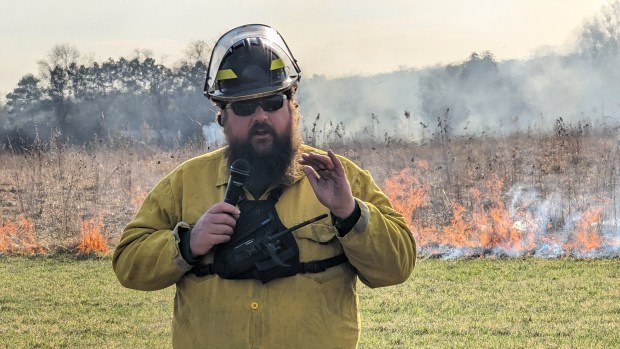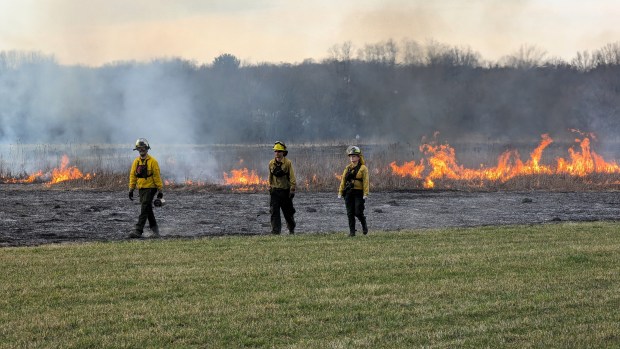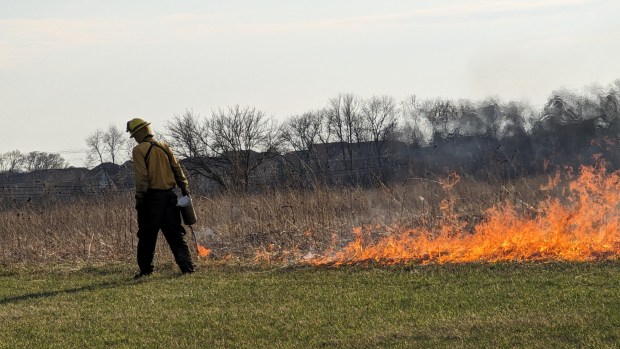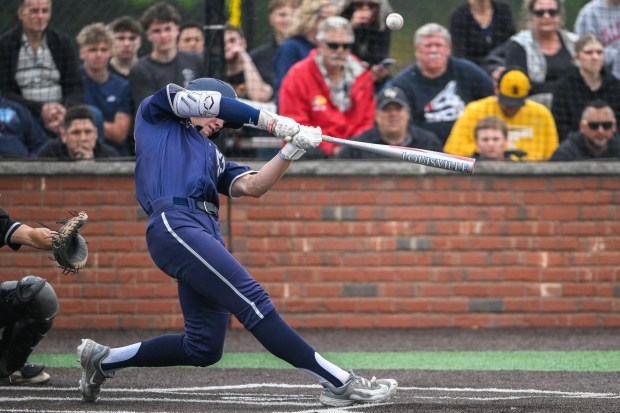The Forest Preserve District of Kane County offered a fiery presentation last week on how they maintain large stretches of wild land.
Using controlled fires, the district clears out thousands of acres of prairies, woodlands and even wetlands over the fall and late winter each year. For the first time, members of the public last Thursday got an up close and personal look at one of these controlled burns with accompanying narration from Kane County Forest Preserve District Senior Restoration Technician and frequent Burn Boss Peter Dall.
Sitting in lawn chairs or blankets on a strip of mowed green grass, onlookers listened to Dall discuss the importance of maintaining natural lands through burns and the techniques used by the forest preserve district to start and contain the fire.
Behind Dall, a 30-acre plot of prairie near the LeRoy Oakes Forest Preserve’s Creek Bend Nature Center in St. Charles burned and spewed white smoke up into the sky.
“A lot of these native plant communities rely on fire. They’ve adapted with fire,” Dall said. “It also knocks back the non-native species that we don’t want in there, the woody species. It will top-kill them and set them back so that those native species can then thrive and come up.”
During the presentation, Dall explained that various plots of land throughout the forest district are “prescribed” fires like a doctor prescribes medicine. These prescriptions include the area to be burned, the correct weather conditions needed for a burn and any safety precautions needed before a burn takes place.
These plots of land are sectioned off through natural or man-made barriers, such as rivers, roads or the 30-foot strip of green grass that onlookers watched the fire from on Thursday, Dall explained.
Once weather conditions are right, fire crews go out and start a controlled burn on the downwind side of the plot, which is called a “backfire,” he said.
Once the backfire has burnt wide enough, the sides of the plot are then lit, starting downwind and moving into the wind, according to Dall. He said this creates two strips of fire on either side, which eventually meet in the middle and, when they begin to burn backwards, meet with the backfire.
After the sides are burning in, a fire is lit on the upwind side of the plot, which is called the headfire, Dall said. He explained that the headfire and the two fires on the flanks burn hotter than the backfire because they are pushed along by the wind.

“It’s just kind of closing in the box, and then normally your fire will meet in the middle,” Dall said. “Once it hits those other lines of fire, there’s nothing else to burn, and it goes out.”
As one fire crew member lit the fire with a hand torch on Thursday, others walked behind with special tools or rode nearby in ATVs equipped with water hoses. Occasionally the fire would move onto the strip of grass or other barriers, but it would be quickly pushed back by the crew’s hand tools or water from the ATV.
The controlled burn on Thursday took around an hour and a half, which is a “fairly typical” amount of time, according to the fire’s Burn Boss Jason Johnson.
Although the wind did not blow exactly as the crew expected, which sent the smoke in different directions than planned, the fire was easy to contain and the crew had no issues, he said.

Weather is an important factor in planning controlled burns, according to Dall. He said the wind and humidity have to be just right before the burn can begin, so those who wanted to attend the event on Thursday needed to sign up weeks in advance but only got a 48-hour warning about when it would be taking place.
Wind can help carry the fire, while moisture determines what will and won’t burn, Dall explained. On days when there is little wind, such as last Thursday, the fire has a more difficult time getting started and needs more help, which means the crew must start more lines of fire in the plot of land, he said.
While the crew wants the moisture level of most plants to be low so that the burn has enough fuel, it is sometimes useful for large objects like logs to still be a bit wet so that they do not catch on fire, according to Dall. He said this prevents crews from having to manually go put out these long-burning objects, which prolongs the process.
Not every plot of land needs the same weather conditions, either, Dall explained.
For example, he said wind direction is considered to blow smoke away from residents or busy roads and over forest preserve land. As another example, he said some areas like woodlands require heavy wind to penetrate through the thick treeline and help push the fire along.

Native Americans first used fire to manage natural lands, according to Dall. He said the process actually helps native plants to grow better by cutting away invasive species, making the soil darker and therefore hotter in the sun, clearing away debris and reintroducing nutrients to the soil.
Some large plants, such as the oak trees in the prairie burned on Thursday, are unaffected by the fire and continue to grow despite the flames, Dall explained.
He said the prairie near the LeRoy Oakes Forest Preserve’s Creek Bend Nature Center was planted around 2014 or 2015 and since then has burned four times, including the burn on Thursday. The oak trees, planted with the prairie almost 10 years ago, continue to grow.
The plot of prairie burned on Thursday will likely be green in just a few weeks, with flowers in a few months that will last until the fall, he said.
In addition to regular maintenance burns, the forest preserve district sometimes burns plots of land to replant them or do other management, according to Dall. He said that the district wants to burn around 25% of its natural land, or around 4,000 acres of land, per year, but this year has only been able to burn about 2,600 acres.
The burn on Thursday was the last of the season, but the first time the public was invited, according to Kane County Forest Preserve Executive Director Benjamin Haberthur. He said the program was designed to show the public how safe the burns are.
“Prescribed burning is a big part of what we do. It’s our most cost-effective way to manage the natural resources,” Haberthur said. “We get a lot of questions on it throughout the year.”
Although controlled burns are done for the year, Haberthur said the district is planning to have more public showcases of the process in the future considering the success of the first one on Thursday.
“We want the public to feel safe about what we’re doing,” he said. “It’s also just super fun.”
rsmith@chicagotribune.com





